
Playlists
 |
Playlist Playlists |
| Le dark
ladies e le femmes fatales al cinema Dark ladies and femmes fatales in the movies |
|
| Nota: E' disponibile una
versione
pdf di questo Dossier. |
Note: A
pdf version
of this Dossier is available. |
|
Versione italiana English version |
|
|
All'inizio di Appuntamento con la morte, a una veduta aerea di una grande città di
notte segue una visione di una strada, da cui si sentono provenire le
sirene della polizia ... lo zoom ci avvicina ad una
finestra all'ultimo piano di un edificio, e contro la luce della stanza
inquadrata si staglia una figura di donna in nero ... La donna sta
fumando, guarda imperturbabile verso di noi, poi fuori dalla finestra,
mentre le sirene si fanno sempre più vicine ... Potrebbe essere la presentazione visiva della femme fatale, la donna dal fascino erotico irresistibile a cui l'uomo non può sottrarsi, e che lo irretisce fino alla morte ... Elemento dominante del noir classico hollywoodiano degli anni '40 e '50 del secolo scorso, la dark lady costituisce uno dei motori (se non il più importante) della storia narrata da questi film. Sfuggente e misteriosa, ambiziosa e crudele, esercita il suo potere di attrazione sull'uomo, fino a farne suo complice, e in realtà spesso sua vittima, di macchinazioni delittuose che hanno quasi sempre come posta in gioco il denaro e/o il potere. E l'uomo finisce sempre per cadere in questa trappola, con conseguenze disastrose, non solo per lui, ma per la sua stessa seduttrice. (Ricordiamo per inciso che in quegli anni era in vigore il codice censorio Hays, che prevedeva una "giusta punizione" per chi sullo schermo si presentasse come eroe del male, della corruzione e della violenza.) |
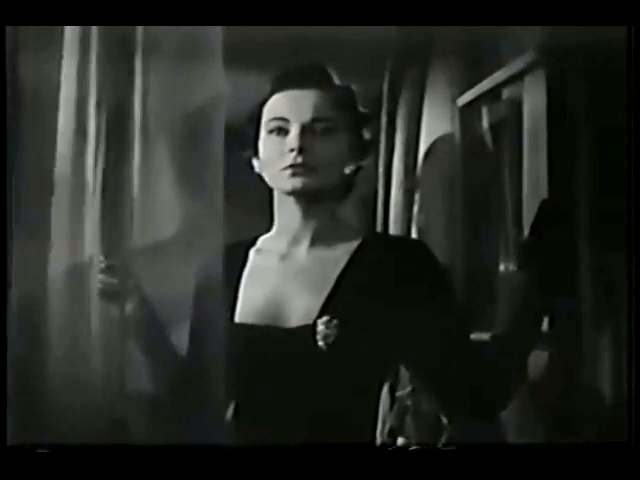 Appuntamento con la morte/One-way street (di/by Hugo Fregonese, USA 1950) |
At the beginning of One-way street, an aerial view of a large
city at night is followed by a vision of a street, from which police
sirens can be heard... the zoom brings us closer to a window on the top
floor of a building, and against the light of the framed room a figure
of a woman in black stands out... The woman is smoking, she looks
imperturbably towards us, then out the window, while the sirens get
closer and closer... This could be the visual presentation of the femme fatale, the woman with irresistible erotic charm from which man cannot escape, who ensnares him until his death... A dominant element of the classic Hollywood noir of the '40s and '50s of the last century, the dark lady constitutes one of the driving forces (if not the most important one) of the story told by these films. Elusive and mysterious, ambitious and cruel, she exerts her power of attraction on man, to the point of making him her accomplice, and in reality often her victim, of criminal machinations which almost always have money and/or power as their final purpose. And the man always ends up falling into this trap, with disastrous consequences, not only for him, but for his own seductress. (Let us remember, incidentally, that in those years the Hays censorship code was in force, which provided for a "just punishment" for anyone who presented him/herself on the screen as a hero of evil, corruption and violence.) |
| Precursore di questa "figura maledetta" può ben essere considerata la Irina (Simone Simon) di Il bacio della pantera, una donna di origini slave, discendente di una setta maledetta, che si trasforma in una pantera nera quando è sessualmente eccitata. Il matrimonio con Oliver (Kent Smith) non fa dunque che peggiorare le cose. Irina diventa gelosa di una collaboratrice di Oliver, Alice (Jane Randolph) e comincia a perseguitarla. Il fascino e il valore di questo film, a metà tra il noir e l'horror, non sta nel mostrare (la pantera non si vede mai), ma nel suggerire, tramite un uso sapiente dei movimenti di macchina, delle luci e degli effetti sonori, la presenza minacciosa della belva. In questa sequenza, ad esempio, mentre Alice fa una nuotata in piscina, barlumi di luce e strani ruggiti creano per lo spettatore un'identificazione immediata con il terrore di Alice, tanto più che viene presto raggiunta da Irina, serena e cordiale ... e il terrore continua quando un'inserviente mostra ad Alice il suo accappatoio, lacerato come se fosse stato addentato da una belva ... |
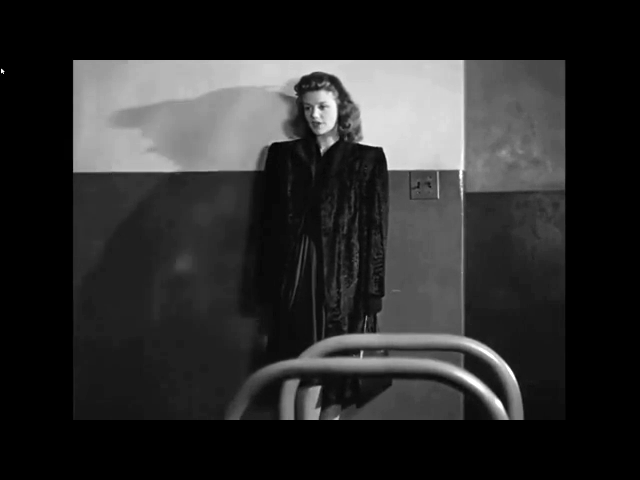 Il bacio della pantera/Cat people (di/by Jacques Tourneur, USA 1942) |
The forerunner of this "cursed figure" can well be considered Irina (Simone Simon) from Cat people, a woman of Slavic origins, descendant of a cursed sect, who transforms into a black panther when sexually aroused. Her marriage to Oliver (Kent Smith) therefore only makes things worse. Irina becomes jealous of Oliver's co-worker, Alice (Jane Randolph) and begins to stalk her. The charm and value of this film, halfway between noir and horror, does not lie in showing (the panther is never seen), but in suggesting, through a skilful use of camera movements, lights and sound effects, the threatening presence of the beast. In this sequence, for example, while Alice takes a swim in the pool, glimmers of light and strange roars create for the viewer an immediate identification with Alice's terror, especially as she is soon joined by Irina, serene and friendly... and the terror continues when an attendant shows Alice her bathrobe, torn as if it had been bitten by a beast... |
| Il prototipo
della femme fatale è forse la Phyllis (Barbara Stanwyck) di La
fiamma del peccato, capolavoro di Billy Wilder, in cui la donna
convince un assicuratore, Walter (Fred MacMurray) a stipulare una
polizza sull'inconsapevole marito, allo scopo evidente di eliminarlo con
l'aiuto di Walter e di incassare il malloppo. In questa prima sequenza,
Walter, pur non essendo insensibile al fascino della donna, capisce
subito il suo piano delittuoso, e, nonostante le pressioni di Phyllis,
decide di lasciarla perdere ... |
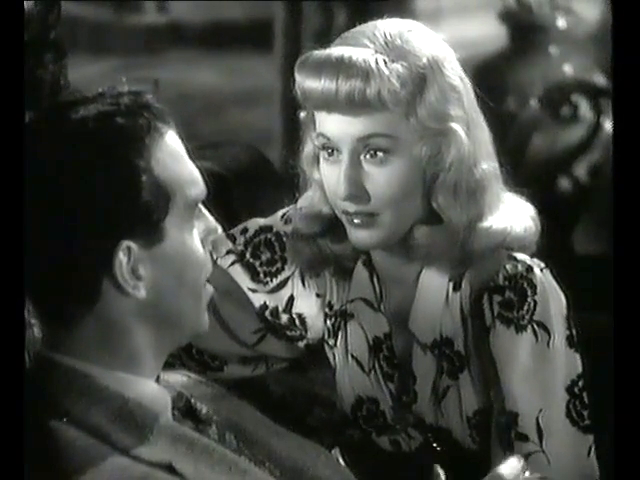 La fiamma del peccato/Double indemnity (di/by Billy Wilder, USA 1944) |
The prototype of the femme fatale
is perhaps Phyllis (Barbara Stanwyck) in Double indemnity, Billy
Wilder's masterpiece, in which the woman convinces an insurer, Walter
(Fred MacMurray) to take out a policy on the unaware husband, for the
obvious purpose of eliminate him with Walter's help and collect the
loot. In this first sequence, Walter, although not insensitive to the
woman's charm, immediately understands her criminal plan, and, despite
Phyllis' pressure, decides to let her go... |
| Ma non per molto. La passione travolgente che si sviluppa tra i due porta effettivamente alla realizzazione del piano. Ma in una delle sequenze finali, la resa dei conti diventa inevitabile. I due amanti riconoscono di essere entrambi "infami", si accusano di aver usato il partner per i propri fini, e Phyllis giunge a dire a Walter di non averlo mai amato, ma solo di averlo manipolato. Quale conclusione si prò prevedere per una vicenda così torbida? Nel disperato tentativo di "farla franca" comunque, Phyllis spara a Walter, ma lo colpisce solo a una spalla ... e quando lei gli si avvicina per un ultimo abbraccio, lui la stringe a sè, ma solo per spararle un colpo mortale. Mai amore e morte sono stati così intensamente legati come in questa sequenza, dove l'ambizione sfrenata e la manipolazione degli affetti raggiungono un'espressione tanto realistica quanto crudele e totale. |
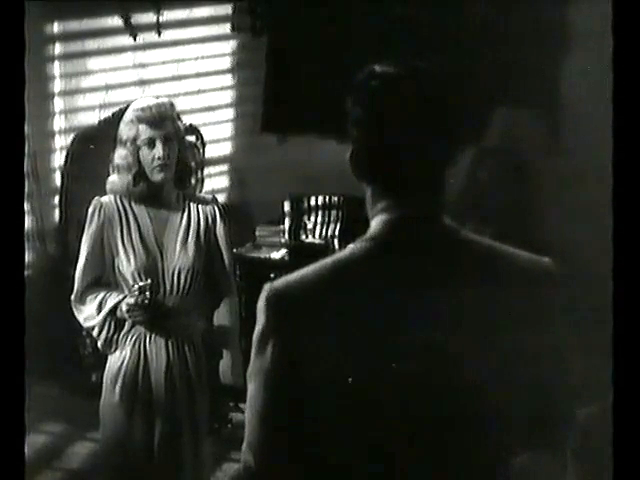 La fiamma del peccato/Double indemnity (di/by Billy Wilder, USA 1944) |
But not for long. The overwhelming passion that develops between the two actually leads to the realization of the plan. But in one of the final sequences, the showdown becomes inevitable. The two lovers recognize that they are both "infamous", they accuse each other of having used their partner for their own ends, and Phyllis goes so far as to tell Walter that she has never loved him, but only that she has manipulated him. What conclusion can we foresee for such a murky affair? Desperate to "get away" anyway, Phyllis shoots Walter, but only hits him in the shoulder... and when she approaches him for one last hug, he pulls her close, only to fire a fatal shot at her. Never have love and death been so intensely linked as in this sequence, where unbridled ambition and the manipulation of affections reach an expression that is as realistic as it is cruel and total. |
| Leave her to heaven, recita il titolo originale di Femmina folle - ossia "lasciala pure in cielo", perchè non c'è posto per lei in questo mondo. E in effetti la Ellen protagonista del film (Gene Tierney) è una variante particolare della dark lady - una donna che, dietro la facciata bellissima e appassionata, nasconde in realtà disturbi psichici estremamete gravi e pericolosi. Dopo avere frettolosamente sposato Richard (Cornel Wilde), che di lei si è invaghito immediatamente e pazzamente, comincia a dimostrare i segni del suo squilibrio: la sua gelosia possessiva non arretra di fronte a nulla che possa essere di ostacolo al suo dominio esclusivo su Richard. Come in questa sequenza, dove accompagna il fratello minore e handicappato di Richard (Darryl Hickman) a fare un bagno in un lago. Ellen incoraggia il ragazzo a dare il meglio di sè, lo spinge ad avventurarsi al largo, finche il ragazzo si sente male e lei assiste, imperturbabile dietro i suoi occhiali neri, alla sua morte. Così ha eliminato un avversario del suo folle attaccamento al marito, ma non è finita qui ... finirà addirittura per lasciarsi cadere dalle scale per evitare di portare a termine una gravidanza che, ai suoi occhi, non sarebbe stata altro che una nuova minaccia al suo rapporto ossessivo con Richard. Sì, Ellen è decisamente un tipo da "lasciare in pace nel suo paradiso" ... |
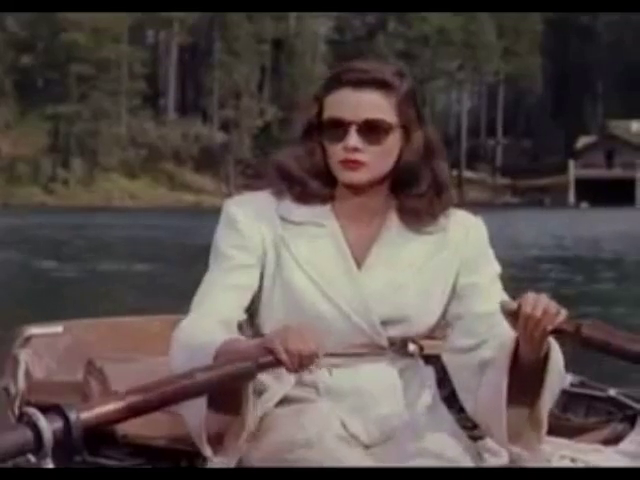 Femmina folle/Leave her to heaven (di/by John M. Stahl, USA 1945) |
Leave her to heaven, says the title of this film - in fact there is no place for her in this world. And Ellen, the main cvharacter (Gene Tierney) is a particular variant of the dark lady - a woman who, behind the beautiful and passionate facade, actually hides extremely serious and dangerous mental disorders. After hastily marrying Richard (Cornel Wilde), who immediately and madly falls in love with her, she begins to demonstrate the signs of her imbalance: her possessive jealousy does not retreat in the face of anything that could be an obstacle to her exclusive domination on Richard. As in this sequence, where she accompanies Richard's handicapped younger brother (Darryl Hickman) for a swim in a lake. Ellen encourages the boy to give the best of himself, pushes him to venture out into the open water, until the boy feels ill and she witnesses, imperturbable behind her black glasses, his death. Thus she has got rid of an adversary in her crazy attachment to her husband, but that's not all... she will even end up letting herself fall down the stairs to avoid carrying to term a pregnancy which, in her eyes, would have been nothing more than a new threat to her obsessive relationship with Richard. Yes, Ellen is definitely a "leave her alone in her paradise" type... |
| Ancora una donna fatale, ma soprattutto ambiziosa e priva di scrupoli, Lily (Gaby Rodgers) è la protagonista di Un bacio e una pistola, un noir diventato un classico di culto per aver introdotto livelli di violenza e di sordida tensione che hanno costituito una svolta nel noir americano. Al centro della vicenda c'è una valigetta, ritenuta preziosa per qualche strano motivo e di cui più persone cercano di impadronirsi, a partire dal detective Mike (Ralph Meeker) e da uno scienziato, il dottor Soberin (Albert Dekker). Nel corso di un'intricata vicenda assistiamo a scene di una violenza inaudita per l'epoca (segno di un deterioramento della società e, in modo particolare, del clima di sfiducia e sospetto generato dalla famosa "caccia alle streghe" comuniste promossa dal senatore McCarthy), finchè, in una delle sequenze finali, gli intrighi si risolvono direttamente eliminando gli avversari: nel tentativo di entrare in possesso del prezioso quanto misterioso oggetto, Lucy finisce per uccidere prima Soberin e poi Mike, riuscendo finalmente ad aprire la valigetta ... ma la violenza non risparmia nessuno, tanto meno chi ha rinunciato ad ogni valore morale: dalla valigetta si sprigiona un'energia mortale, di cui la stessa Lucy, inorridita, farà le spese. Un finale tragico e pessimista, degno di un mondo dove i valori sono sovvertiti e non esiste più nessuna responsabilità morale. |
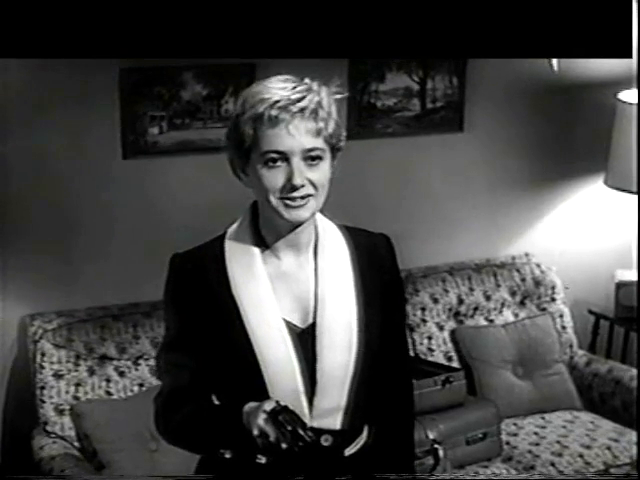 Un bacio e una pistola/Kiss me deadly (di/by Robert Aldrich, USA 1955) |
Still a femme fatale, but above all ambitious and unscrupulous, Lily (Gaby Rodgers) is the protagonist of Kiss me deadly, a noir that has become a cult classic for introducing levels of violence and sordid tension that constituted a turning point in American noir. At the centre of the story is a briefcase, considered valuable for some strange reason and which several people try to get hold of, starting with detective Mike (Ralph Meeker) and a scientist, Dr. Soberin (Albert Dekker). During an intricate story we witness scenes of unprecedented violence for the time (a sign of deterioration of society and, in particular, of the climate of mistrust and suspicion generated by the infamous communist "witch hunt" promoted by Senator McCarthy ), until, in one of the final sequences, the intrigues are resolved directly by eliminating the adversaries: in an attempt to gain possession of the precious and mysterious object, Lucy ends up killing first Soberin and then Mike, finally managing to open the briefcase... but violence spares no one, much less those who have renounced all moral values: a deadly energy is released from the briefcase, for which Lucy herself, horrified, will pay the price. A tragic and pessimistic ending, worthy of a world where values are subverted and moral responsibility no longer exists. |
| Negli anni '70, e soprattutto negli anni '80, la femme fatale si rinnova e acquista nuovi risvolti di carattere, in linea con i tempi, la caduta delle ideologie e la nuova libertà sessuale (vera o presunta) che permette ai film di mostrare nuovi livelli di violenza e soprattutto di erotismo. Anche in questo filone di "neo-noir" c'è una figura precorritrice: è la donna fatale di Chinatown, Evelyn (Faye Dunaway), al centro di un'intricatissima vicenda poliziesca che vede come altro protagonista il detective privato J.J.Gittes (Jack Nicholson). La storia si svolge nel 1937, con evidenti rimandi alle detective stories tipiche di quegli anni, ma anche con una ricostruzione storica-filologica inappuntabile, che fa rivivere i fasti del noir classico ma non nasconde evidenti rimandi al presente. Un presente dove la corruzione regna sovrana e si insinua nei rapporti pubblici e privati senza via di scampo, trascinando con sè vite personali e un'intera società. In questa sequenza, il detective Gittes incontra Evelyn, che lo ha appena assunto per indagare sulla morte del marito. Ma non si tratta di un semplice contratto, ma dell'inizio di una relazione tormentata e complessa, in cui i due giocano un po' come il gatto col topo: lui disincantato e un po' cinico, lei fredda e calcolatrice. L'uomo qui è diventato meno sprovveduto e più consapevole, ma anche la donna sa giocare le carte della seduzione e del mistero, cercando i manipolare le situazioni a suo vantaggio. Anche in questo caso l'esito non sarà felice, e il detective, che pure ha cercato per tutto il film di stare "dalla parte giusta", si ritroverà impotente di fronte ad un sistema malavitoso che ha ormai impregnato di sè tutta una società. |
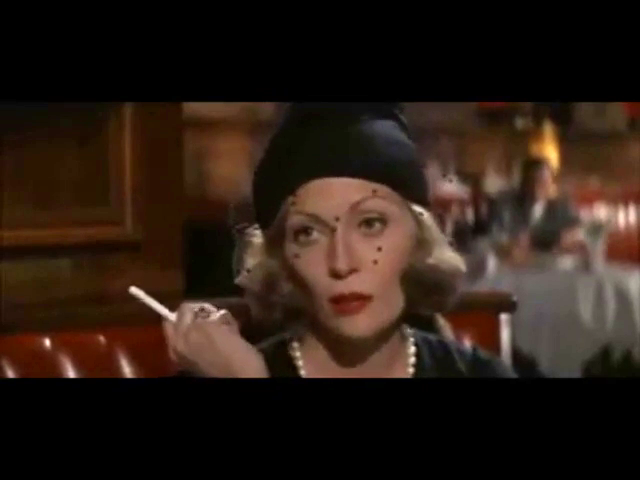 Chinatown (di/by Roman Polanski, USA 1974) |
In the '70s, and especially in the '80s, the image femme fatale is re-vamped and acquires new aspects, in line with the times, the fall of ideologies and the new sexual freedom (real or presumed) that allowed films to show new levels of violence and above all of eroticism. Even in this "neo-noir" genre there is a harbinger: the femme fatale of Chinatown, Evelyn (Faye Dunaway), at the centre of a very intricate detective story whose other protagonist is the private detective J.J. Gittes (Jack Nicholson). The story takes place in 1937, with clear references to the detective stories typical of those years, but also with an impeccable historical-philological reconstruction, which revives the glories of classic noir but does not hide obvious references to the present. A present where corruption reigns supreme and insinuates itself into public and private relationships with no way out, dragging with it personal lives and an entire society. In this sequence, Detective Gittes meets Evelyn, who has just hired him to investigate her husband's death. But it is not a simple contract, but the beginning of a tormented and complex relationship, in which the two play a bit like cat and mouse: he is disenchanted and a little cynical, she is cold and calculating. The man here has become less naive and more aware, but the woman also knows how to play the cards of seduction and mystery, trying to manipulate situations to her advantage. Even in this case the outcome will not be happy, and the detective, who has tried throughout the film to be "on the right side", will find himself powerless in the face of a criminal system that has now permeated an entire society. |
| Il neo-noir
può ormai dipingere ritratti di uomini, e soprattutto di donne, dalla
sensualità torrida ed esplicita. E' ciò che capita ad un avvocato, Ned
(William Hurt), che inizia una eroticissima relazione con una donna
bellissima e sensuale, Matty (Kathleen Turner) in Brivido caldo.
Nella prima sequenza, lo vediamo approcciare questa femme fatale
in un bar, e quando lei osserva che lui è il primo tra gli uomini
presenti ad essere riuscito a sedersi accanto a lei, lui prima le dice
che "non dovrebbe vestirsi così, e alla rimostranze di lei ("E' solo una
camicetta"), lui prontamente replica, "Non dovresti portare quel corpo".
|
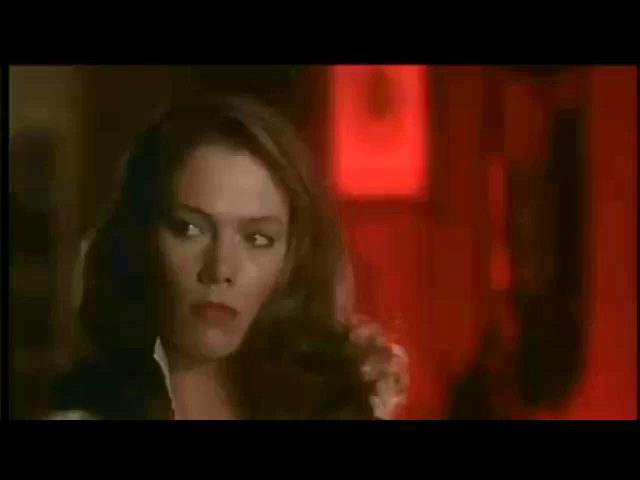 Brivido caldo/Body heat (di/by Lawrence Kasdan, USA 1981) |
Neo-noir can now paint portraits of men, and especially women, with torrid and explicit sensuality. This is what happens to a lawyer, Ned (William Hurt), who begins a very erotic relationship with a beautiful and sensual woman, Matty (Kathleen Turner) in Body heat. In the first sequence, we see him approach this femme fatale in a bar, and when she remarks that he is the first of the men present to have managed to sit next to her, he first tells her that "she shouldn't dress like that", and to her remark (“It's just a blouse”), he promptly replies, “You shouldn't wear that body.” |
| Più tardi, nella seconda sequenza, dopo un iniziale e molto ambiguo rifiuto di Matty di instaurare una relazione con Ned, quest'ultimo, ormai ossessionato da questa cocente passione, finisce per rompere la porta di casa e lanciarsi verso Matty, che di fatto lo sta aspettando, impietrita ma altrettanto vogliosa. E' solo l'inizio di un incubo: Matty, in ossequio alla tradizione, è infelicemente sposata con un uomo ricchissimo, di cui vorrebbe subito ereditare il patrimomio, e nel suo piano criminoso coinvolge ovviamente Ned. L'epilogo di questi noir degli anni '80 è ormai diverso rispetto ai film dei decenni precedenti: i tempi sono cambiati, la censura anche, e così Matty non solo incastra Ned come esecutore del delitto, ma se ne va in vacanza a godersi i suoi soldi ... |
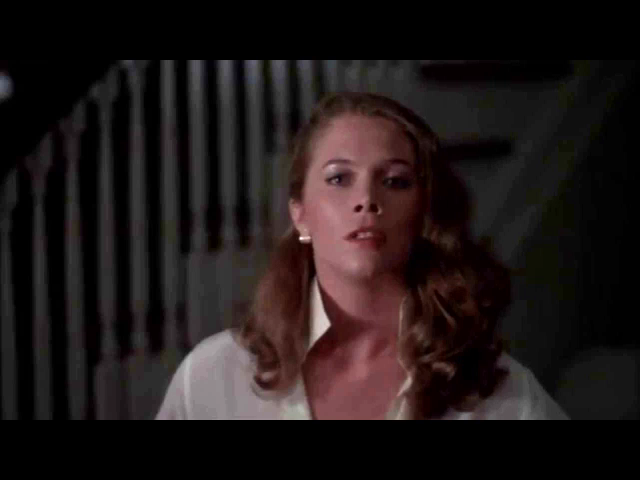 Brivido caldo/Body heat (di/by Lawrence Kasdan, USA 1981) |
Later, in the second sequence, after Matty's initial and very ambiguous refusal to establish a relationship with Ned, the latter, now obsessed by this burning passion, ends up breaking the door of the house and throwing himself towards Matty, who in fact is waiting for him, petrified but equally eager. It's just the beginning of a nightmare: Matty, in accordance with the noir tradition, is unhappily married to a very rich man, whose fortune she would immediately like to inherit, and she obviously involves Ned in her criminal plan. The epilogue of these noirs of the '80s is now different compared to the films of previous decades: times have changed, censorship too, and so Matty not only frames Ned as the perpetrator of the crime, but goes on holiday to enjoy the money... |
| Le frontiere
del neo-noir si spingono sempre più in là fino a toccare argomenti che
sarebbero stati considerati tabù fino a qualche anno prima. In La
vedova nera, ad esempio, un'agente federale (Debra Winger) scopre
che una serie di anziani ricconi muoiono improvvisamente subito dopo il
loro matrimonio. Dalle indagini l'agente risale fino ad una bellissima
donna (Theresa Russell), che finora è riuscita a farla franca. In questa
sequenza, le due donne si incontrano, armi all pari, ad uno dei
matrimoni della dark lady: l'agente regala alla donna una
preziosa spilla, che, ci viene detto, rappresenta un ragno velenoso (la
"vedova nera" del titolo), che, subito dopo l'accoppiamento, ha la
brutta abitudine di uccidere il partner. Ma la scena si carica di una
sensualità torbida e inusuale, poichè è evidente che tra le due donne è
scattata una strana complicità, suggellata dall'improvviso bacio della
femme fatale, che, congedandosi, dice: "Vorrei avere di più da
dividere con te" E anche questa volta sarà la femme fatale a vincere, godendosi il frutto dei suoi piani mostruosi alla Hawaii ... La dark lady non è più ormai vittima dei suoi stessi atti malvagi, ma, in una specie di femminismo al contrario, si gode i frutti dei doni che madre natura le ha dato ... |
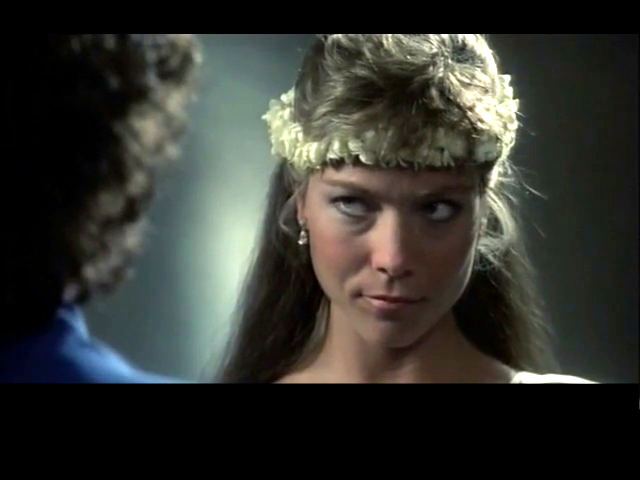 La vedova nera/Black widow (di/by Bob Rafelson, USA 1987) |
The frontiers of neo-noir push
themselves further and further until they touch on topics that would
have been considered taboo until a few years earlier. In Black widow,
for example, a federal agent (Debra Winger) discovers that a series of
wealthy elderly people suddenly die soon after their wedding. From the
investigations the agent traces her way back to a beautiful woman
(Theresa Russell), who has so far managed to get away with it. In this
sequence, the two women meet, on equal terms, at one of the dark lady's
weddings: the agent gives the woman a precious brooch, which, we are
told, represents a poisonous spider (the "black widow" of the title),
which, immediately after mating, has the nasty habit of killing its
partner. But the scene is charged with a murky and unusual sensuality,
as it is clear that a strange complicity has arisen between the two
women, sealed by the sudden kiss of the femme fatale, who, on taking leave,
says: "I wish I had more to share with you " And this time too it will be the femme fatale who wins, enjoying the fruit of her monstrous plans in Hawaii... The dark lady is no longer a victim of her own evil acts, but, in a kind of reverse feminism, enjoys the fruits of the gifts that mother nature has bestowed on her... |
| Le ossessioni distruttive di una mente malata (come nel già visto Femmina folle) tornano anche in Attrazione fatale, naturalmente aggiornate al decennio forse più edonistico di sempre, gli anni '80. Un procuratore legale (Michael Douglas) passa una notte torrida con una sensuialissima donna (Glenn Close), all'apparenza dolce e accomodante. Ma quando lui, considerandola l'avventura di una notte, cerca di lasciarla per mantenere saldo il suo matrimonio, lei comincia a inseguirlo, perseguitarlo, minacciarlo (oggi si direbbe uno "stalking" al contrario), introducendosi persino in casa sua, entrando in rapporto con la moglie di lui, e, in questa sequenza, prima implorandolo, poi cercando di legarlo a sè dicendo di essere incinta, e infine, in un'esplosione di rabbia, decidendo di svelare tutto alla moglie. Ritratto di una rapporto morboso, in cui all'ossessione femminile si unisce la debolezza maschile, il film fece molto discutere all'uscita, in particolare per il tono misogino con cui viene trattata questa storia, in realtà assai comune e messa in scena mille volte anche al cinema. |
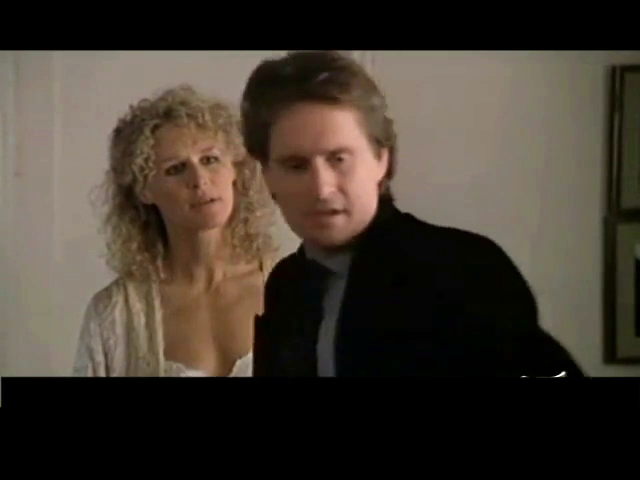 Attrazione fatale/Fatal attraction (di/by Adrian Lyne, USA 1987) |
The destructive obsessions of a sick mind (as in Leave her to heaven) also return in Fatal attraction, naturally updated to perhaps the most hedonistic decade of all time, the '80s. A solicitor (Michael Douglas) spends a torrid night with a very sensual woman (Glenn Close), apparently sweet and accommodating. But when he, considering her a one-night stand, tries to leave her to securer his marriage, she begins to chase him, persecute him, threaten him (today we would call it "stalking"), even entering his house, meeting his wife, and, in this sequence, first begging him, then trying to tie him to her by saying she is pregnant, and finally, in an explosion of anger, deciding to reveal everything to his wife. As a portrait of a morbid relationship, in which female obsession is combined with male weakness, the film caused a lot of discussion upon release, in particular for the misogynistic tone with which this story is treated, which in reality is very common and has been staged a thousand times even in the movies. |
| Una figura
complessa, anche se in parte stereotipata, è al centro di Basic
instinct, passato alla storia come uno dei più audaci (per l'epoca)
ritratti di personaggio femminile (falsamente) emancipato ed abilissimo
nello sfruttare un sistema sociale (e innanzitutto una società di
uomini) per i suoi fini personali. Catherine (Sharon Stone) è una
scrittrice bisessuale (!) che sembra avere la curiosa abitudine di
uccidere con un punteruolo da ghiaccio (!) i suoi amanti nel momento
dell'amplesso. Di lei si invaghisce follemente un detective (ancora
Michael Douglas, ormai avvezzo a questi ruoli), che avrà il suo bel da
fare per cercare (invano) di incriminarte Catherine. Nella sequenza più
famosa del film, diventata ormai di assoluto culto, Catherine viene
interrogata da una squadra della polizia. Seduta da sola di fronte a
questo gruppo di uomini, visibilmente turbati ed eccitati dalla
situazione, Catherine ha tutta la spavalderia e la cialtroneria per
dominare completamente l'interrogatorio: vestita in uno scintillante
abito bianco, con la sigaretta tra le dita, ad un certo punto accavalla
le gambe (e lo spettatore è stato furbescamente e preventivamente
avvertito che non porta biancheria intima), mandando letteralmente in
tilt il team di esperti ... Misoginia? Maschilismo? Catherine è
innanzitutto, come il film, una dark lady furba e pronta a
sfruttare a suo vantaggio l'ipocrisia non così latente di una società
dove i ruoli sessuali sono ormai messi in crisi da tempo ... |
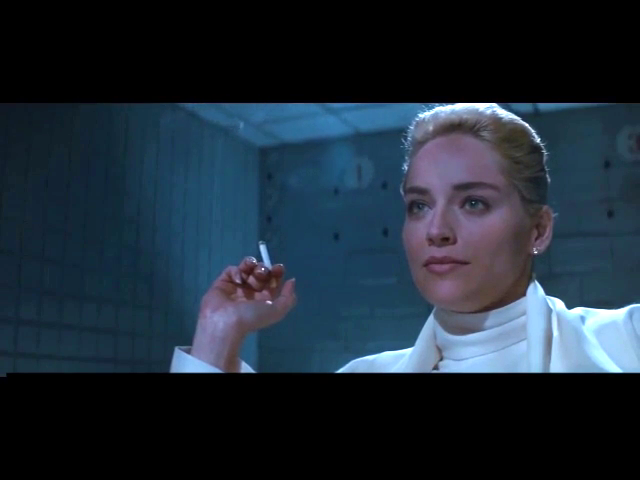 Basic instinct (di/by Paul Verhoeven, USA 1992) |
A complex figure, even if partly stereotyped, is at the centre of Basic instinct, which went down in history as one of the most daring (for the time) portraits of a (falsely) emancipated female character who is very skilled in exploiting a social system (and above all a society of men) for her personal purposes. Catherine (Sharon Stone) is a bisexual writer (!) who seems to have the curious habit of killing her lovers with an ice pick (!) while having sex with them. A detective (Michael Douglas again, now accustomed to these roles) falls madly in love with her and will spare no means to try (in vain) to incriminate Catherine. In the most famous sequence of the film, which has now become an absolute cult, Catherine is interrogated by a police team. Sitting alone in front of this group of men, visibly upset and excited by the situation, Catherine has all the bravado and quackery to completely dominate the interrogation: dressed in a sparkling white dress, with a cigarette between her fingers, at a certain point she crosses her legs (and the viewer has been cunningly and preventively warned that she is wearing no underwear), literally sending the team of experts into a tailspin... Misogyny? Male chauvinism? Catherine is first and foremost, like the film, a crafty dark lady ready to exploit to her advantage the not so latent hypocrisy of a society where sexual roles have been in crisis for some time ... |
| Una figura solo in parte diversa,ma in realtà figlia dei suoi tempi, è quella di Suzanne (Nicole Kidman) che, in Da morire, lavora come presentatrice delle previsioni del tempo in una piccola televisione locale. Ma la sua ambizione è sconfinata: dato che "non sei nessuno se non appari in tv", non esita a pianificare l'assassinio del marito per poter finalmente essere libera di scalare quelle che ritiener essere le vette del successo. Per farlo, non trova di meglio che sedurre due ragazzi e una ragazza perchè siano gli esecutori del delitto. In questa sequenza la vediamo all'opera mentre si presta a tenere una specie di lezione sul suo lavoro ad una classe di adolescenti, tra cui figurano i due ragazzi che compiranno il misfatto. Sin dal suo incedere verso la scuola, e poi in classe, Suzanne non fa che fare bella mostra di sè e del suo lavoro audiovisivo che è tutta la sua vita, provocando con i suoi sorrisi ammiccanti e i suoi comportamenti seducenti le reazioni dei giovani ascoltatori. In particolare, il ragazzo che sarà poi il perno su cui Suzanne imbastirà l'omicidio del marito, è interpretato da un giovanissimo ma già bravissimo Joaquin Phoenix. Ma questa volta la spregiudicatezza e l'ambizione omicida non daranno per Suzanne i frutti sperati ... |
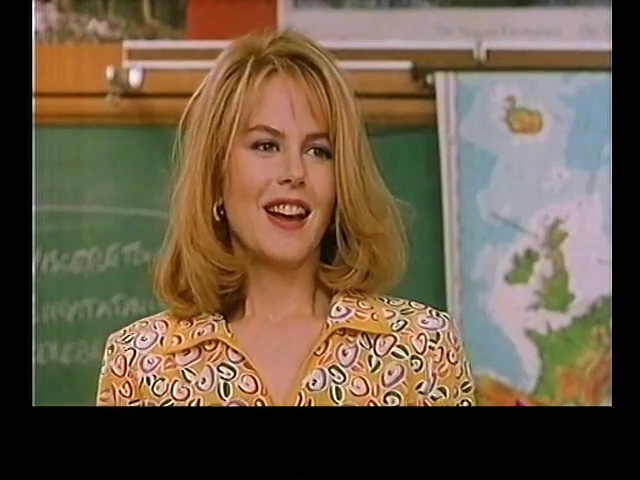 Da morire/To die for (di/by Gus van Sant, USA 1995) |
A figure that is only partially different, but actually a product of her times, is that of Suzanne (Nicole Kidman) who, in To Die For, works as a weather forecast presenter for a small local television station. But her ambition is boundless: since "you are nobody if you don't appear on TV", she does not hesitate to plan her husband's assassination in order to finally be free to climb what she believes to be the heights of success. To do this, she finds nothing better than to seduce two boys and a girl to be the perpetrators of the crime. In this sequence we see her while she gives a sort of lesson on her work to a class of teenagers, including the two boys who will commit the crime. From the moment she walks towards school, and then into the classroom, Suzanne does nothing but show off herself and her audiovisual work which is her entire life, provoking the reactions of the students with her winking smiles and her seductive behaviour. In particular, the boy who will then take central stage in Suzanne's murder of her husband, is played by a very young but talented Joaquin Phoenix. But this time Suzanne's unscrupulousness and homicidal ambition will not yield the desired results ... |
| Come non terminare questa playlist con un film che ha per titolo Femme fatale? Tra l'altro, questa sequenza chiude idealmente il cerchio trattato dalla playlist perchè inizia proprio con la stessa scena, che abbiamo commentato in dettaglio, tratta da La fiamma del peccato, ed esattamente la scena in cui i due amanti arrivano alla resa dei conti finale. De Palma è un cinefilo (in particolare hitchockiano) appassionato, e ciò che vediamo è in realtà trsmesso alla televisione (con sottotitoli francesi): a poco a poco capiamo che c'è qualcuno che sta guardando questo vecchio film, ed è una donna (qui vista solo di spalle), biondissima e bellissima, che nel vero e proprio film gioca proprio il ruolo di una femme fatale. La trama del film è molto intricata, ma è giocata tutta, come thriller erotico, sul contrasto tra realtà e menzogna - cosa che a De Palma riesce particolarmente bene in quanto virtuoso delle inquadrature, delle riprese e della fotografia. |
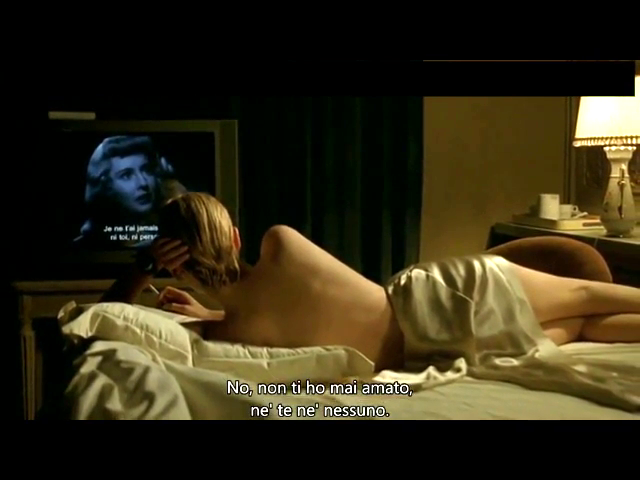 Femme fatale (di/by Brian De Palma, Francia/France 2002) |
How can we not end this playlist with a film entitled Femme fatale? Among other things, this sequence ideally closes the circle covered by the playlist because it begins with the same scene, which we have commented in detail, taken from Double indemnity, the scene in which the two lovers arrive at the final showdown. De Palma is a passionate (particularly Hitchockian) cinephile, and what we see is actually broadcast on television (with French subtitles): little by little we understand that there is someone who is watching this old film, and it is a woman (here seen only from behind), blonde and beautiful, who in the actual film plays the role of a femme fatale. The plot of the film is very intricate, but it is all based, as an erotic thriller, on the contrast between reality and lies - something that De Palma manages particularly well as a virtuoso of framing, filming and photography. |